Setting goals is essential to remain profitable in such a competitive digital space. Hence, you must quantify these objectives to see whether we are on the right path to success or not. As a result, it is no surprise that businesses set goals and track their performance using key performance indicators (KPIs).
However, to effectively monitor the progress of your affiliate marketing program, you must ensure that the affiliate marketing KPIs match well with the industry profile of your company and fit your business goals.
The affiliate channel is the most convenient approach to building your business and raising your earnings while spending very little money. Performance marketing is critical to eCommerce growth when referring to eCommerce businesses that focus on digital marketing techniques to drive sales and income.
Assume you have recently launched an affiliate program, either in-house or through affiliate networks.
Table of Contents
What Is a KPI in Affiliate Marketing?
A key performance indicator (KPI) is a measurable value that shows progress in reaching a business goal.
A KPI in affiliate marketing is a measurable value tied to specific objectives of an affiliate marketing campaign. It indicates progress during the campaign and helps measure the effectiveness at the end of a campaign or a period while running.
KPIs in affiliate marketing are slightly different from standard marketing metrics. KPIs are tied to progress. They show performance related to specific projects and campaigns. Marketing metrics are numbers that should be consistently tracked to understand the status of marketing campaigns and whether they are helping to meet KPIs and business goals.
Why Are KPIs in Affiliate Marketing Important?
Know what KPIs are; you also need to know why KPIs are important.
KPIs in marketing are important because they help you define:
- Where you are going (What are your goals and marketing objectives?)
- How to get there (What do you need to do to reach those goals?)
- If you made it to your final destination (Did your efforts produce valuable results?)
- How to take a better route the next time (What can you change to get better results?)
Without KPIs, creating strategic affiliate marketing campaigns and assessing marketing results is difficult.
Also, KPIs help you prove the value of your marketing campaigns to upper management and clients. You can add KPIs to an affiliate marketing report to illustrate your results.
Without additional further ado, here are the best 15 affiliate marketing metrics (KPIs) you should consider evaluating your affiliate program:
Top 15 Affiliate Marketing Metrics (KPIs)
1. ROAS – Return on Advertising Spend
This is a term commonly used with search affiliates or PPC channels. The reason it’s essential is search affiliates will speak with you about how well their campaigns may be converting and discuss keywords with you, which will produce a higher Return on Advertising spending.
If your PPC efforts run, you need to be strategic about your allowances with search affiliates. However, solid win-win situations will result in mutually beneficial relationships and dual profits for both parties involved.
ROAS is the ultimate metric of any ad campaign.
ROAS = $ revenue made from ads / $ advertising spend * 100
If you make $10,000 and spend $5,000, then your ROAS is 2x or 200%.
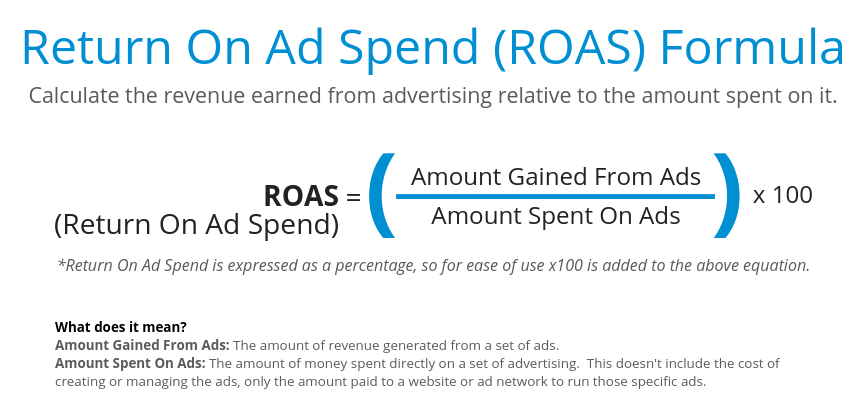
To find the ROAS number, you need to keep track of your deals and sales and track where these customers/leads came from.
What is considered a reasonable ROAS?
Positive is good. The best benchmark would be to compare your return on ads to the return you see on other channels. If it’s much lower, it either means your account needs some help, or it’s not the best channel for you. Alternatively, if you see much higher returns on ads, keep investing!
2. ROI – Return on Investment
Return on investment (ROI) is a performance measure used to evaluate the efficiency or profitability of spending or compare the efficiency of several different investments. ROI tries to directly measure the return on a particular asset relative to the investment’s cost.
To calculate ROI, the benefit (or return) of an investment is divided by the cost of the investment. The result is expressed as a percentage or a ratio.
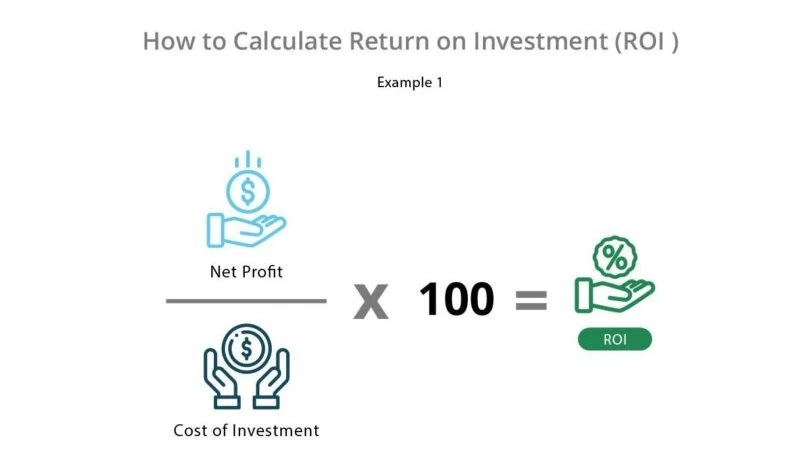
Bottom line, ROI – Return on Investment tells you whether you are producing a positive return, a negative return, or breaking even on your spending. It’s the basis of all business efforts – a positive ROI.
What is the difference between ROAS and ROI?
It would help if you kept in mind that ROI and ROAS differ. When calculating the ROI, you include all other expenses like staff, tools, licenses, etc. In contrast, when calculating ROAS, you only look at your spending with the platforms (outside of agencies, employees, and management fees) to figure if your campaigns were profitable on an ad spend basis alone.
3. Conversion rate
Among the most used KPIs in affiliate marketing is the conversion rate. This provides a solid indication of how successfully those clicks turn into sales. In addition, applying to your affiliate traffic will help you evaluate how effective each of your affiliates is.
It also indicates that the channel’s performance is in contrast to others. Moreover, you can also determine how many clicks are required to generate a single conversion through it.
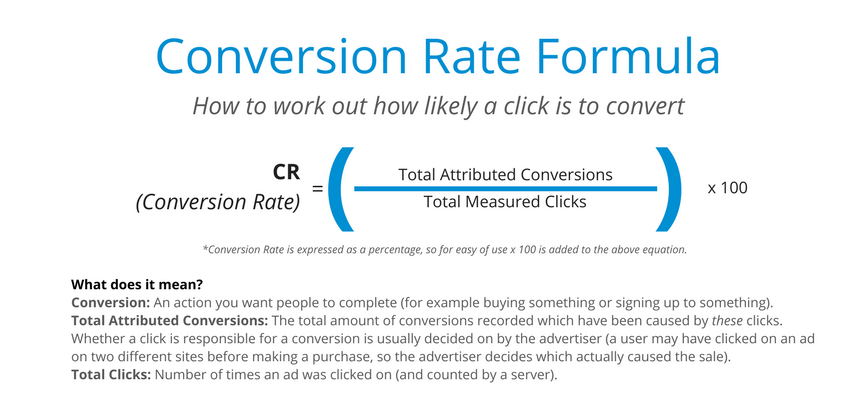
Check for discrepancies in this affiliate marketing KPI, particularly after a specific event. For example, after executing a promotional deal, you would want to look at the improvement in conversion rate to see how well it connected with your audience. Very high rates would indicate that the affiliate’s traffic strongly affinity with your market or that they are using dubious promotional tactics.
Here is a tip for you to increase the conversation rate, you must add value to the entire buying process. You must evaluate and track your affiliate program following links and simulate and troubleshoot the end customer experience.
4. AOV – Average Order Value
To evaluate the profitability of your program and the individual affiliates, you must keep track of one of the vital affiliate marketing KPIs, the average order value.
Average order value is the average amount paid by the customers each time they purchase from you. As a result, a greater average order value indicates that customers spend more on each purchase.
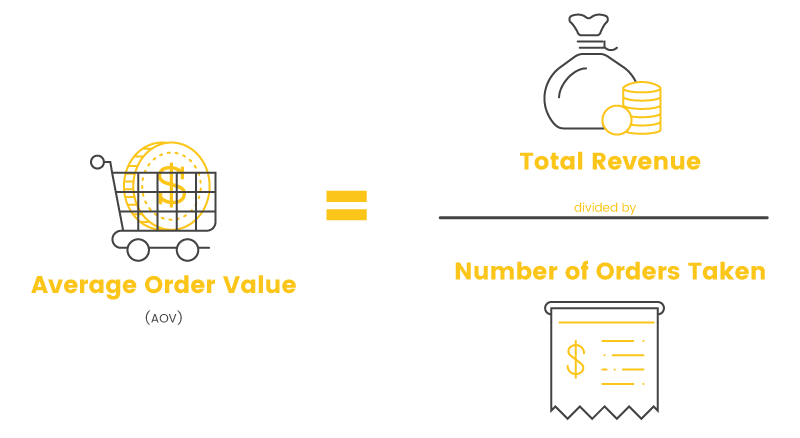
Only monitoring the conversion rate won’t help. We suggest you never overlook your average order value because that influences your business growth. Even if the recorded total of sales generated this year is low, you can still make more money if you have an average order value that is higher in percentage.
The same case is when your affiliate partner isn’t delivering many conversions, they might still be a valuable source of money. For example, they might persuade more high-value clients or customers who spend more money than ordinary customers.
5. Number of sales
The number of purchases made is just as significant as the revenue generated by sales. However, irrespective of the money linked with it, the amount of sales accurately indicates the rate of acquiring customers.
Remember that you are supposed to sell a sufficient number of items in a reasonable time regardless of your product’s price. So in case, your product is exceptionally pricey, selling it at least once a month would indicate that you aren’t doing all possible to get your business off the ground.
It would be beneficial to keep refreshing your products and introducing special promotions and new creatives to make your affiliates happy. Satisfying your affiliates will help you increase your affiliate revenue.
However, never forget about the customer and his end journey. To establish a better plan and execute it well, you must first educate yourself about ToFu MoFu BoFu, the sales funnel.
Here a tip for you is to maximize your affiliate program visibility and increase your number of sales. To make that happen, you must ensure that you get in front of affiliates, which can be done by appearing on marketplace listings relevant to your business niche.
6. Reversed sales rate
Having a track of this KPI will provide valuable information regarding the traffic quality your affiliate partners are bringing your way.
The reversed sales rate is the percentage of consumers that return products purchased from your website for a refund after being previously paid to an affiliate.
Remember, if your reversed sales rate is more significant than 10%, it is likely that the affiliate who sent the traffic is not promoting your product to the correct demographic or is exaggerating some of the product attributes to get the conversion.
However, in most circumstances, you would not be able to determine the reverse sales rate before enrolling in an affiliate network. As a result, you should monitor this rate throughout your affiliate campaign and take preventative measures to protect your organization.
7. Active Affiliates Rate
Your business type will determine whether “active affiliates” means affiliates generating leads, clicks, or sales. To find out your active affiliates rate, divide the number of active affiliates by the total number of affiliates.
Active affiliates rate = # of active affiliates/ total # of affiliates
If the result exceeds 10%, you have targeted your program’s right affiliates and traffic. To increase the number of active affiliates, you should regularly run activation campaigns for your dormant affiliates (typically considered the affiliates that didn’t generate any clicks or sales in the past six months to one year).
Tip: You can always find valuable resources by looking at what other companies achieved with the relevant affiliate marketing metrics.
8. The number of top affiliates
It would be beneficial to develop a habit of keeping track of your top affiliates who bring in the highest revenue every year because losing contact with them would greatly influence your business growth. Hence, you must develop a strong bond with them to avoid this.
You can call a meeting and present all your findings to your team with the help of PowerPoint slide templates. This way, you’ll ensure that everyone knows who is important, never lose sight of the most beneficial affiliates, and maintain a healthy relationship with them.
This affiliate marketing KPI is valuable for tracking which affiliates you should use further to boost your program’s earnings.
In addition, It can also assist you in identifying any performance dips among normally high-performing affiliates. You might wish to seek ways to help them regain control of their performance.
Attributing a custom UTM code to each affiliate is one of the most effective techniques to monitor this affiliate marketing KPI.
9. Affiliate Contribution margin
Loyal customers are the ones who create long-term effectiveness. In affiliate marketing, this means converting affiliates who make one-time sales into affiliates who make recurring sales. Affiliates who make recurring sales are especially effective on the B2B side, where the average product value is higher.
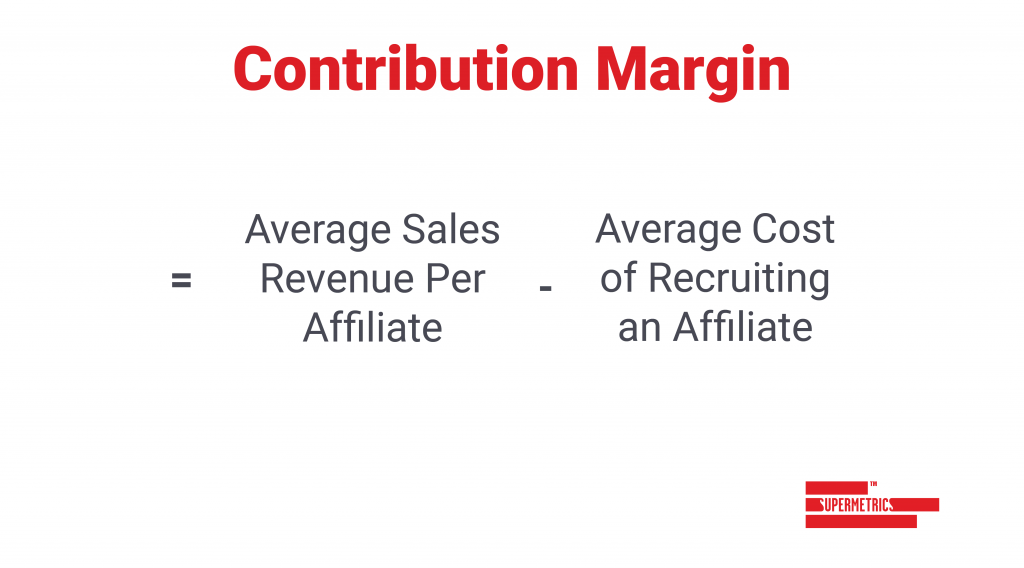
Your contribution margin is a more relevant KPI for marketing effectiveness. As an affiliate program manager, you can measure your contribution margin by calculating the average sales revenue from an affiliate minus the average cost of recruiting an affiliate. It takes the quality of your affiliates into account. A high conversion rate is not of much value unless those affiliates bring you actual sales.
10. Cost per sale Or Cost per lead
How much are you spending to get those all-important affiliate sales? Measuring how much you pay to secure each sale and comparing this to other marketing platforms’ costs can help determine if your affiliate marketing efforts are worth it.
You might also measure cost per lead if you’re a B2B with a longer sales cycle and paying affiliate commissions for qualified leads.
11. Incremental revenue
The affiliate channel’s ultimate purpose is to give incremental revenue to customers who affiliates have introduced. Customers are not associated with other marketing channels like emails, SEM, etc. On the other hand, remember that defining and evaluating additional revenue is not always straightforward.
To figure out the incremental revenue, you should add the overall revenue, i.e., the base revenue, for a given period, whether for half a year or the whole year. Then, after launching the affiliate campaign, calculate your income and subtract the base revenue. This way, you’ll get your incremental revenue rate. To effectively present all the calculations, you can establish your presentation utilizing the timeline template. Its infographic slides would let you present less complexly, making it understandable for your audience.
Let’s take an example: assume that you own a T-shirt shop with an essential revenue of $27,000/year to make this work clearer. You have joined a particular affiliate program. After that, you earn $32,000 over the next three months. This equates to $5,000 in additional revenue.
However, it is impossible that you get the absolute complete 100 % of incremental sales through an affiliate. Remember, the goal is to figure out how much of your sales are incremental and if that is enough for your company or not.
12. Click Traffic Rate
The number of clicks on your website you could get through your affiliate marketing program in a given amount of time reveals how well your product is promoted through affiliate channels.
The click rate is a crucial measure of how effectively your affiliate marketing program is expanding, and it’s an essential affiliate marketing KPI to keep track of.
Examine this KPI to see which sites, affiliates, or networks provide the most visitors and which are not. Nevertheless, this is a terrific technique to narrow down your program’s most profitable routes.
For instance, if you generated fewer clicks this year than last, your program will likely diminish and result in fewer purchases. On the other hand, if you’re experiencing an increase in traffic this year, your program is most likely expanding, forming new and fruitful relationships, and generating more revenue.
Following are the vital click traffic questions that you must never lose sight of:
- Who are your top affiliate partners contributing to driving traffic?
- Do those partners generate the traffic converting into leads or high-value sales?
- What partners should be driving quality traffic?
- What can be done to get them going?
13. Cost per click and cost per sale
Compared with other marketing platforms like Facebook ads or AdWords, these two performance measures, cost per click and cost per sale, are beneficial. Having them, you can calculate the average cost of each new customer you have acquired.
Note that the affiliate sales statistics in your advertising dashboard can be highly beneficial when reporting. First, however, you should look at your program quality metrics to identify what is working well for you and what is actionable to understand your affiliate sales source better.
According to Mihaela Olaru, “Knowing the EPC, you can easily estimate profit per click in every situation and, implicitly, choose the most profitable solutions for them.
Whether for choosing which programs to promote next or for drawing the line and assessing the profitability of already-made efforts, EPC remains the best performance indicator for affiliate marketers.”
14. Difference between Gross Orders and Net Orders
Another important affiliate marketing KPI you must track is the difference between your gross and net orders.
By gross order, we mean the total sales your affiliate program generates. On the other hand, net orders equal the total number of gross orders minus all returned or canceled orders.
By keeping track of this number, you might be able to spot problems like fraud, logistical failure, and a lack of quality control, among other things. For instance, if you have a large number of gross orders whereas a much smaller number of net orders, this could indicate a problem. You can then take action according to the requirements at the right time.
On another account, Whether you are getting a lot of returns because of the same issue, you should look into it to see if there is any truth. Or else, it could serve as an indication of an affiliate scam. By that, it means the affiliate program in which a partner uses deceptive methods to place many orders to increase their commission.
15. Category-Wise Performance
If you are operating a program with several types of affiliates, it is vital to keep track of each category’s performance. Hence, these affiliate marketing KPIs efficiently determine which clients you’re attracting.
Let’s imagine that discount websites provide most of your program’s earnings. This means you are attracting more customers from the bottom stage of the sales funnel—those already familiar with your products and services. Increasing sales and conversions is your top priority will serve as a good indicator.
Whereas, if you are getting more money from content partners, it would suggest that your affiliate program is bringing in more clients from the initial stage, top of the sales funnel. In this case, if brand recognition is your priority, then this is a good indicator. To match the unique aims of your business or program, you might shift your focus to the concerned affiliate category.
Monitor Affiliate Marketing KPIs and Prove Your Results
Now that you know what KPIs are in affiliate marketing and which ones are the most popular. Decide which KPIs align with your campaigns and goals, then use them to monitor your performance, analyze your results, and show the value of your work.
Start creating reports that clearly show management, decision-makers, or clients the results of your work.
Affiliate Marketing Metrics FAQ
What Is a KPI in Affiliate Marketing?
Why Are KPIs in Affiliate Marketing Important?
What is the most important affiliate marketing KPIs (metrics)?
What is the difference between ROAS and ROI?
Conclusion
Remember that nothing happens overnight, especially when it comes to business growth. Therefore, you must ensure that you stay consistent with your plans and track everything you do to have a clear map of what works for you and what doesn’t and needs to be improved.
If these KPIs are overwhelming for you now, I recommend hiring an affiliate marketing consultant to help you choose the metrics you should track and the best way to do it.
To monitor your affiliate program performance, you must watch the metrics discussed in this article. It is critical to have a strategy for tracking and reviewing your affiliate program’s goals regularly. I recommend starting your affiliate program using a WordPress affiliate plugin or affiliate network that offers extensive tracking capabilities so you can monitor your KPIs.
This is essential in determining where changes may be made and new techniques to implement to keep your affiliate program growing.
 Monetize.info We Help You Grow & Monetize Your Online Business!
Monetize.info We Help You Grow & Monetize Your Online Business!



![Is an Affiliate Program Right for Your Online Business? [PROs & CONs, Examples]](https://monetize.info/wp-content/uploads/2024/07/Is-an-Affiliate-Program-Right-for-Your-Online-Business-310x165.webp)



